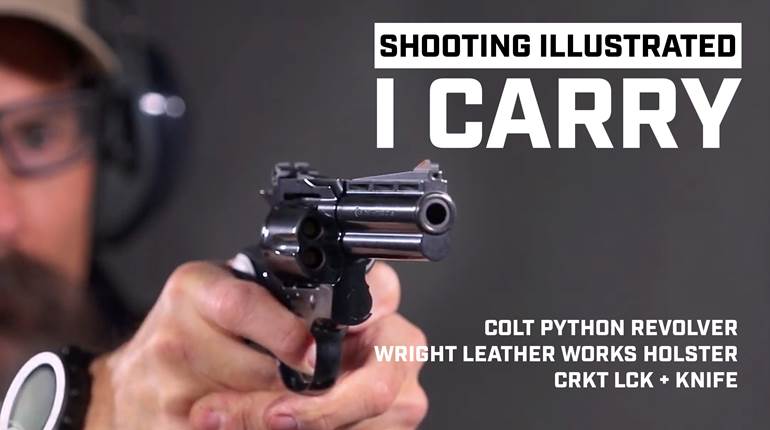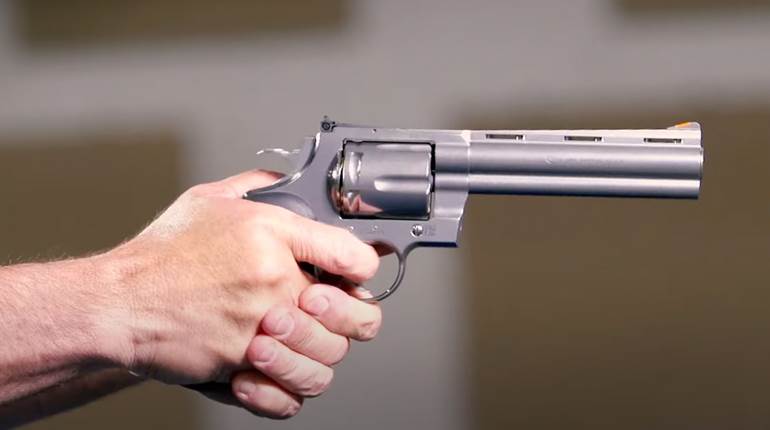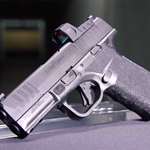
Like countless other baby boomers who grew up in the 1950s and '60s during the Golden Age of TV Westerns, I was fascinated not only by tall-in-the-saddle heroes like Hoppy, Gene and Roy and later by James Arness as Matt Dillon of Gunsmoke, Richard Boone as Paladin in Have Gun—Will Travel and Hugh O’Brian in The Life And Legend of Wyatt Earp, but by the Colt Single Action Army revolvers they so deftly handled. Arness never lost a gunfight during the opening sequence of Gunsmoke, Boone dramatically holstered his SAA without spinning it, and O’Brian was amazingly fast with both his 4¾" inch and 12" Buntline Special single actions, having been taught by Arvo Ojala, Hollywood’s pre-eminent gun coach of that era. Ojala was also the “man in black” that Arness gunned down during Gunsmoke’s opening credits, until the producers realized if they didn’t keep showing Ojala in every opening sequence, they wouldn’t have to keep paying him residuals. That’s why you no longer see him after the eighth season.
Of course, growing up in Phoenix, Ariz., in those early years, I also saw plenty of Colt Peacemakers still being packed by ranchers, hunters and sheriffs. Even the waitresses at Bill Johnson’s Big Apple restaurant on Van Buren Avenue wore sixguns, which complemented the Western motif of this no-longer-extant landmark eatery. And then there were used gun stores like the Jewel Box in downtown Phoenix and Tom Moody’s Stop N’ Swap on Washington Avenue, where you could handle and examine genuine Single Action Army revolvers in various barrel lengths and calibers on the pretext of buying one. Of course, these were all First Generation guns—SAAs made between 1873 and 1941—because in those days, that was all there was. Or all there was ever likely to be, because in August 1949, Colt announced in The American Rifleman that its legendary Model P, with its “antiquated” design, would not be brought back from its World War II hiatus.
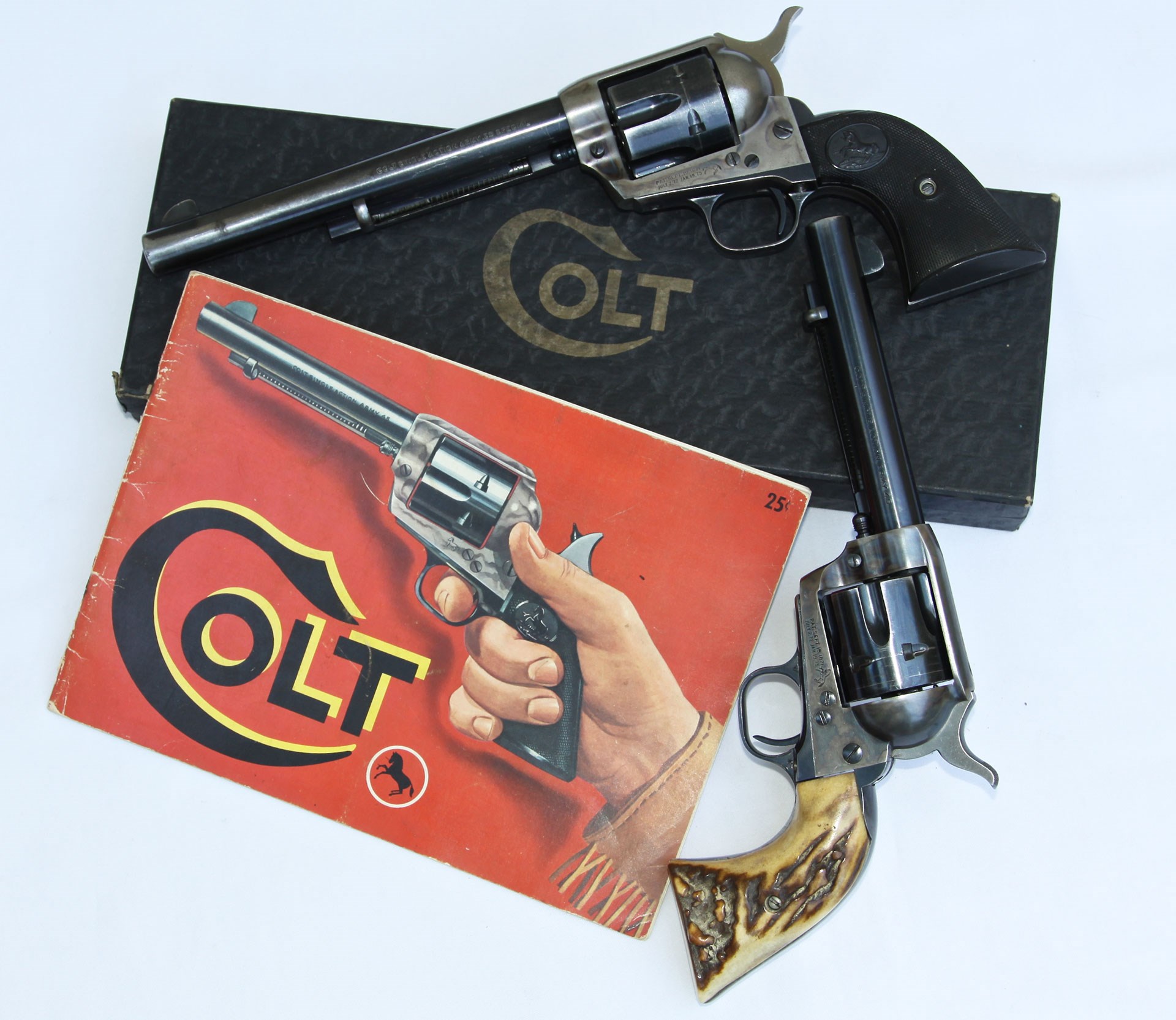 This rare 1956 Colt catalog marked the first time the Second Generation Single Action Army was introduced, shown here with a first year production 7 ½" barrel .38 Spl. with original box, and a 1959-era .45 Colt with 5 ½" barrel. These were the only two versions available until 1958, when the 4 ¾" barrel was brought out.
This rare 1956 Colt catalog marked the first time the Second Generation Single Action Army was introduced, shown here with a first year production 7 ½" barrel .38 Spl. with original box, and a 1959-era .45 Colt with 5 ½" barrel. These were the only two versions available until 1958, when the 4 ¾" barrel was brought out.
Unfortunately, the executives of Colt at that time had failed to notice the rising clouds of dust on the horizon, coming from the encroaching posse of television Westerns. Finally, in 1955, thanks to the TV cowboy craze, the resultant growing sport of fast-draw competition, and no doubt further prompted by Ruger’s previous entry into the single action market with its Single Six in 1953 and pending larger-framed Blackhawk, Colt was spurred into reviving its Model P. It was welcome news for single-action aficionados, for now you could see and handle this legendary six-shooter, new and in the box, and if you had $125, you could actually own what has become known as “Second Generation” Peacemakers, guns that were eventually made from 1955 until 1975.
Produced on much of the original machinery as first generation guns, parts of the resurrected Single Action Army were interchangeable with first generation guns. In fact, for all practical purposes, the second generation Peacemaker was simply a continuation of the original Model P. The guns were handsomely blued with casehardened frames and hard rubber two-piece stocks; two-piece walnut stocks were added a few years later. Nickel-finished guns could only be special-ordered at first, but by 1958, they became standard options. And aside from some minor barrel and inspector stamping differences, there were a few other changes. The most notable were the serial numbers, which now had an “SA” suffix, beginning with 1001SA, and which were only stamped on the bottom of the frame in front of the trigger guard and on the inside of the trigger guard strap and backstrap. The rear of the cylinder was stamped with the Rampant Colt logo, and from 1955 until 1957, the front of the cylinders were stamped with a two-digit assembly number, but from 1958 on, cylinder fronts were stamped with the last digits of the gun’s serial number.
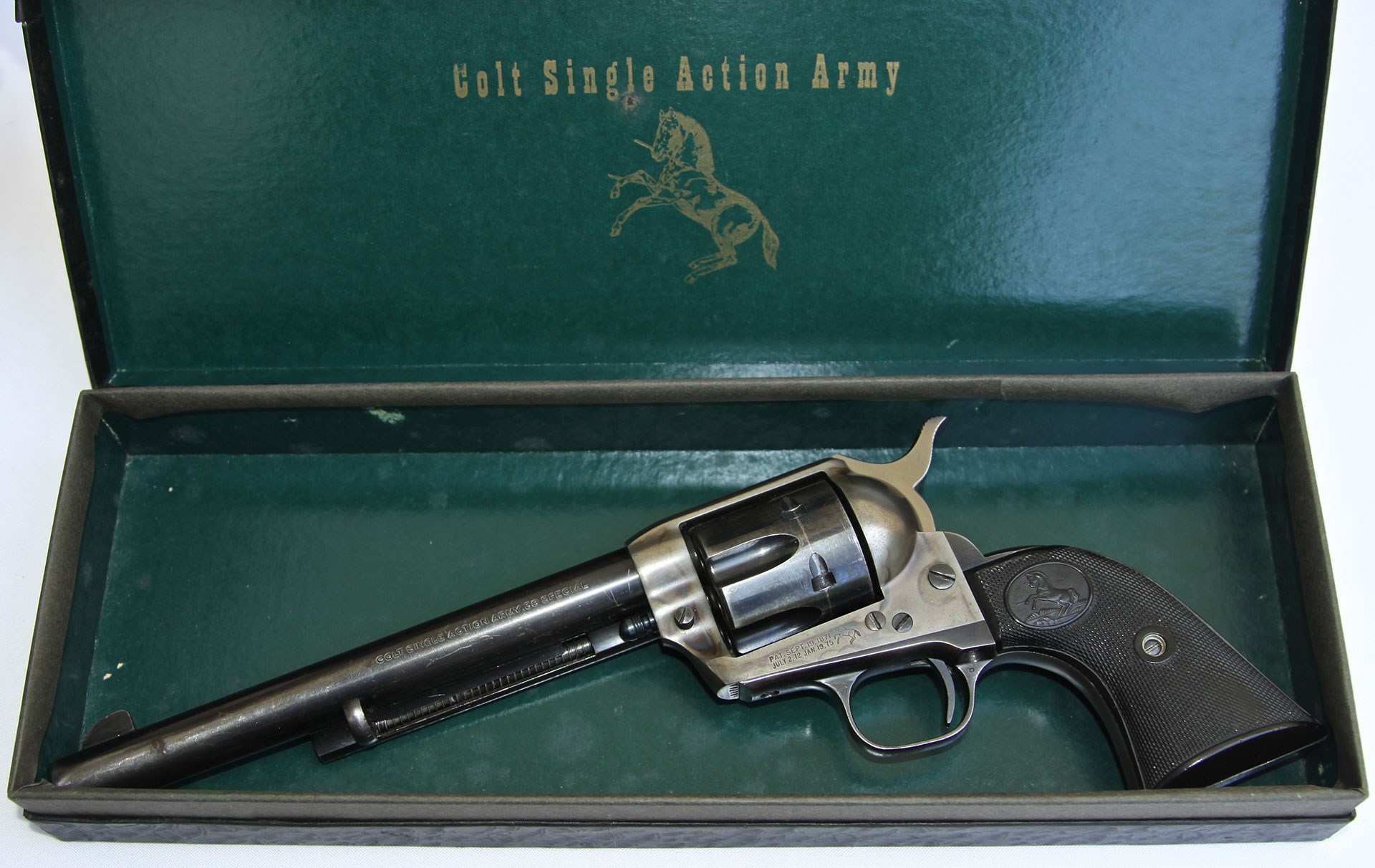 Second Generation .38 Spl. revolvers with 7½" barrels, such as this first-year production gun, are difficult to find today, as this caliber was only produced for a few years and many were converted to .45 Colt and rebarreled to 4¾" or 5½" by fast-draw fans.
Second Generation .38 Spl. revolvers with 7½" barrels, such as this first-year production gun, are difficult to find today, as this caliber was only produced for a few years and many were converted to .45 Colt and rebarreled to 4¾" or 5½" by fast-draw fans.
Only eight guns were shipped in 1955, with two of them being consecutively numbered 5½"-barreled SAAs sent to noted movie producer Cecil B. DeMille, an ardent gun collector whose personal First Generation single-actions had appeared in many of his Westerns. But starting in January 1956, SAA production took off at a gallop. Initially chambered for the classic .45 Colt cartridge as well as .38 Spl. (although why the more popular and powerful .357 Mag. wasn’t offered instead has always been a mystery to me), these Second Generation Colts were initially only available in two of the Peacemaker’s original three barrel lengths: 5½", and 7½". But because of the popularity of the TV show, “The Life And Legend of Wyatt Earp,” a 12" Buntline Special version of the SAA was brought out in 1957, and a year later, Colt added what was to become its most popular barrel length—4¾"—along with a .44 Spl. chambering, which, oddly enough, was only offered in 5½" and 7½" barrel lengths. In 1960, the .357 Mag. was finally introduced, thus completing the only four factory chamberings ever cataloged for Second Generation Model Ps, but not surprisingly, resulted in the .38 Spl. being discontinued in 1964.
Being priced slightly below what a First Generation Colt in excellent condition was going for at the time and a little bit more than a pre-war SAA in 65 percent to 75 percent condition was bringing in those days, the Second Generation guns found their niche with both shooters and collectors. As a result, a number of variations were subsequently added, including an adjustable-sighted flat top New Frontier (with NF suffix serial numbers) starting in 1961, more than 60 limited-edition commemorative examples produced between 1961 and 1974, plus 503 3"-barreled Sheriff’s Models, with serial numbers ending in SM, that were commissioned by Centennial Arms in 1960.
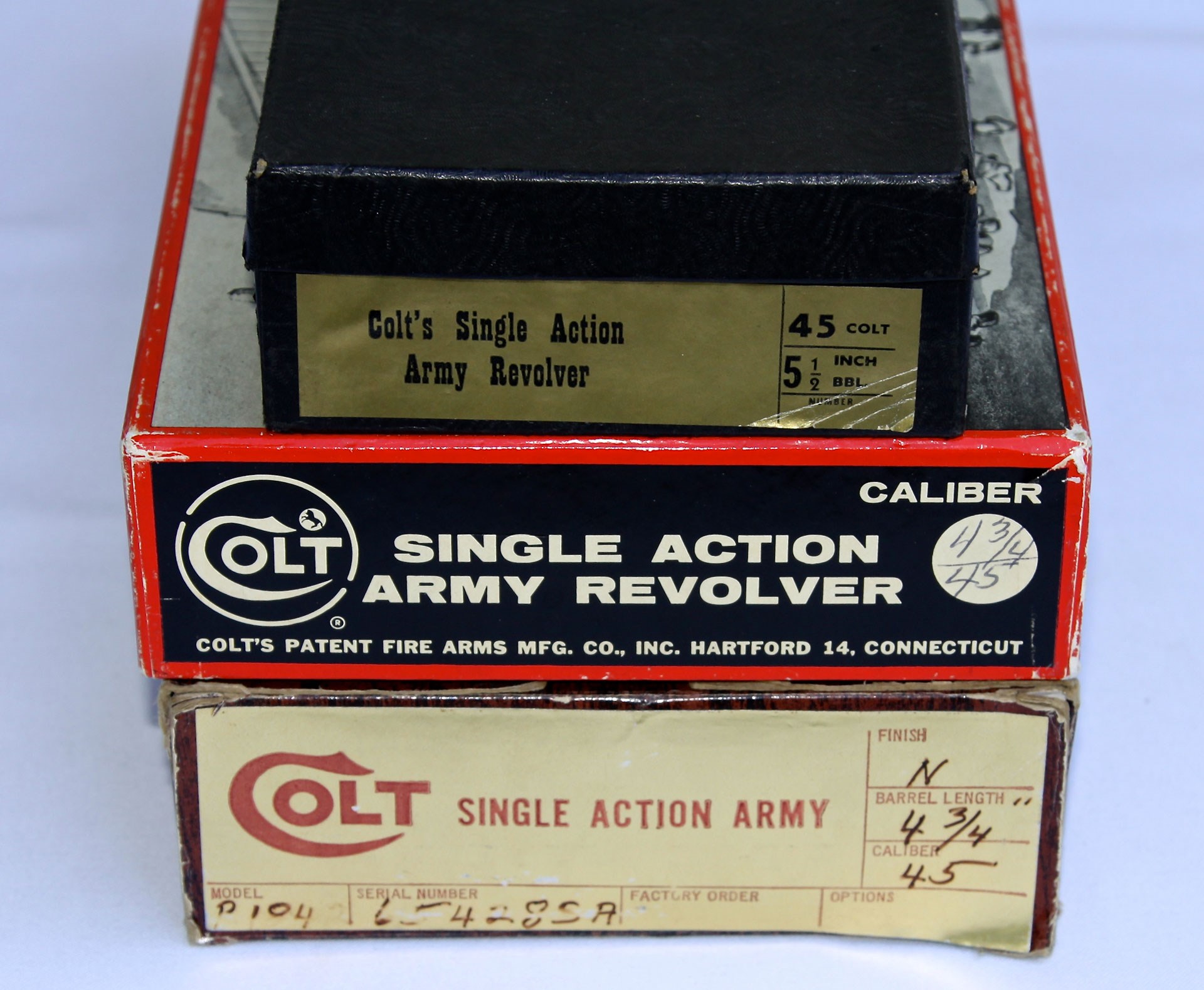 The three different Second Generation box styles are: (top to bottom) black box (1955-1964), stagecoach box (1965-1973), and wood grain box 1973 onwards; various shades of wood grain colors were used throughout its production.
The three different Second Generation box styles are: (top to bottom) black box (1955-1964), stagecoach box (1965-1973), and wood grain box 1973 onwards; various shades of wood grain colors were used throughout its production.
But, by 1975, after producing a little less than 70,000 Second Generation guns, the old Model P machinery was wearing out and production was halted for retooling that year, ending with serial number 73319SA. Production resumed less than a year later, beginning with a new series of serial numbers starting with 800000SA, thus initiating what has become known as “Third Generation” Single Action Armys. The first guns were sent to numerous gun magazines to announce the return of the famous Peacemaker. But some gun writers claimed it wasn’t the same old "Thumbuster." For one thing, the cylinder base pin bushing was no longer a separate slip-in piece, but was permanently press-fit as part of the cylinder itself, which in turn required a differently-machined “hand” affixed to the hammer (note: current Third Generation guns have since gone back to a separate bushing).
In addition, many complained the barrels were “crush fit” onto the frames, when in fact, the threads of Third model barrels and frames were different than those on First and Second generation guns. Nonetheless, all of this simply increased the demand for existing Second Generation SAAs, and I remember one dealer discounting his Third Generation guns, echoing the claim that it wasn’t the same Model P. I immediately bought two and would have bought more if I could have afforded it! After all, besides being great shooters, Colt Peacemakers—no matter what their vintages—have proven to be good investments.
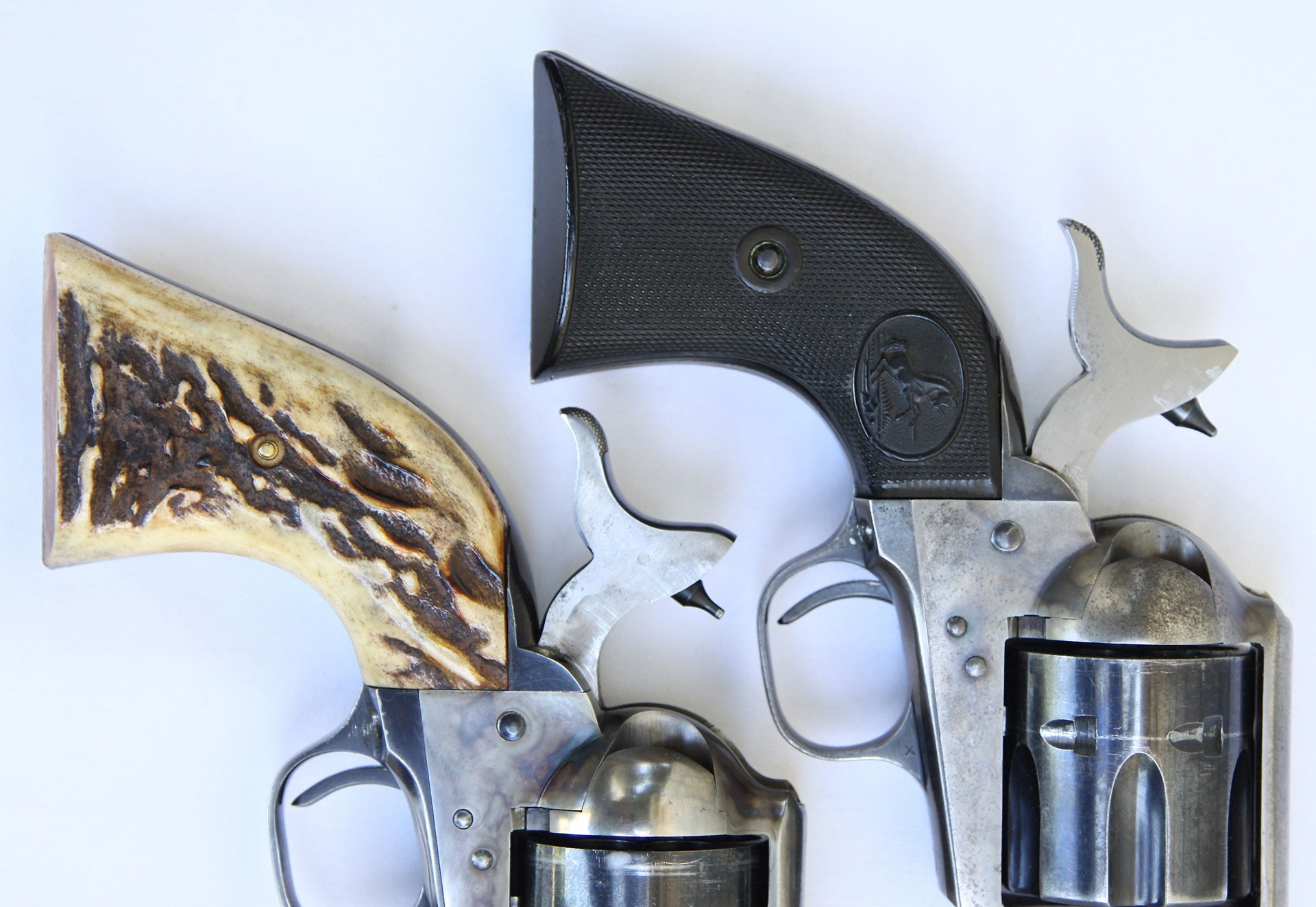 There were four different hammer styles during the Second Generation’s twenty-year span. The first (right) is identical to pre-war SAA hammers, and as Wilkerson notes in his book, Colt Single Action Handbook 1955-1975, some may have been leftover pre-war hammers. The second style (left) reflected the fast-draw craze during the late 1950s and early '60s, and features a rounded contour for faster cocking.
There were four different hammer styles during the Second Generation’s twenty-year span. The first (right) is identical to pre-war SAA hammers, and as Wilkerson notes in his book, Colt Single Action Handbook 1955-1975, some may have been leftover pre-war hammers. The second style (left) reflected the fast-draw craze during the late 1950s and early '60s, and features a rounded contour for faster cocking.
Adding to confusion among today’s collectors, between 1976 and 1978 some leftover Second Generation frames with SA suffixes were used to assemble Third Generation guns. Thus, many early Third Generation Peacemakers have been mistaken for Second Generation guns based upon their SA suffix serial numbers. But in 1978, Third Generation guns began using newly machined frames, replacing the old SA suffix with SA prefix serial numbers.
The easiest way to tell whether you have a Second or Third generation SAA is to examine the cylinder. If it has a rampant Colt on the back and serial numbers stamped on the front, it is a Second Generation Model P—assuming the serial number has an SA suffix, of course, as Second Generation cylinders have been encountered on First Generation guns. However, current Third Generation guns now sport serial numbers that begin with an “S” and end with an “A.”
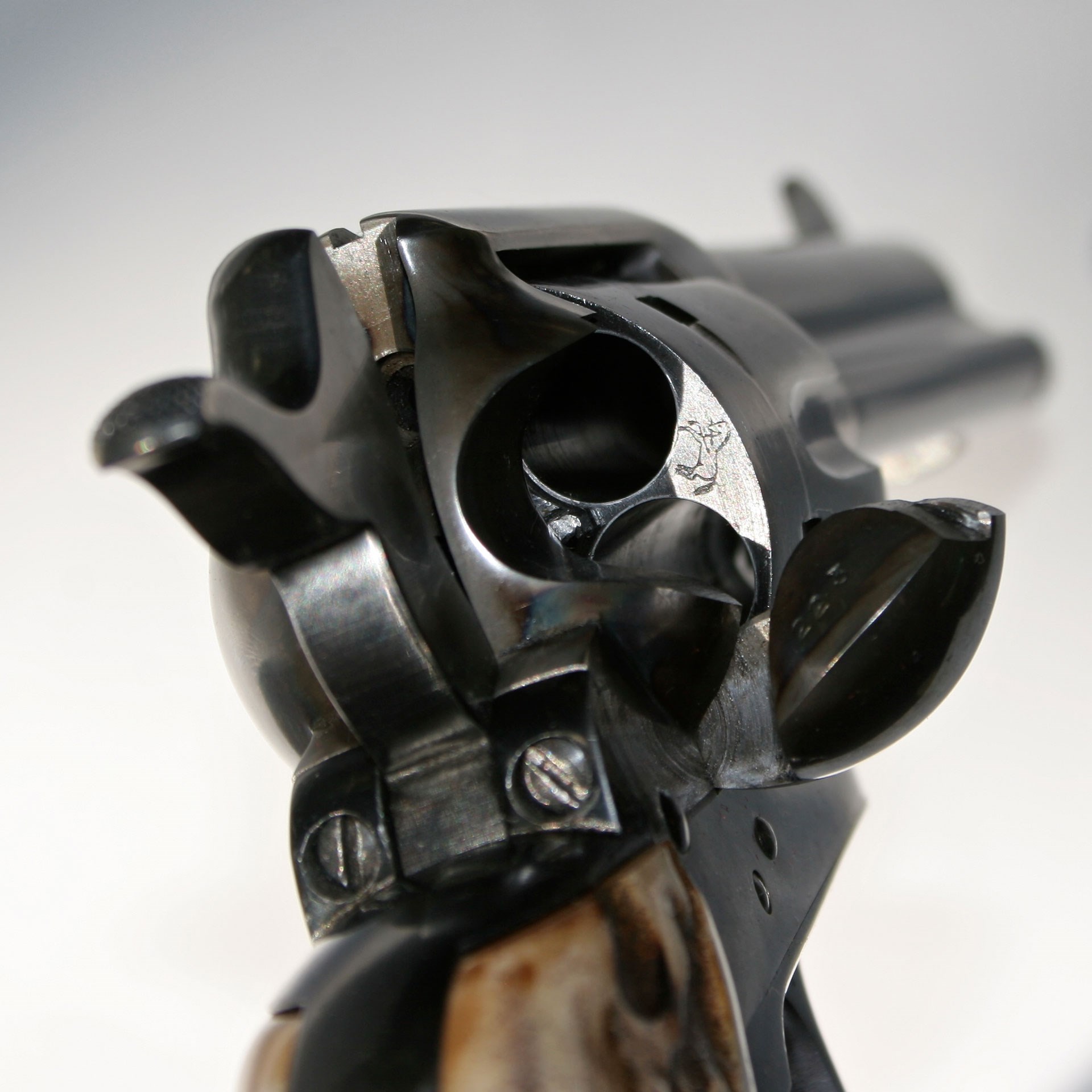 The distinctive Rampart Colt stamp only appeared on Second Generation cylinders. It was omitted on Third Generation cylinders.
The distinctive Rampart Colt stamp only appeared on Second Generation cylinders. It was omitted on Third Generation cylinders.
Yes, Third Generation Single Action Army revolvers are still being made, with a suggested retail price of $1,799, but are only available in .45 caliber, blued and casehardened, although variations can be special-ordered for additional costs through the Colt Custom Shop.
Although Third Generation guns have been made with a greater variety of features, including blackpowder frames and special editions, Second Generation Colts have risen to a collectable status all their own, with factory nickeled guns commanding a slight premium over blued and casehardened versions. The most popular Second Generation barrel length has always been 4¾", closely followed by 7½". Nonetheless, Colt decided to put its 5½" version on the cover and inside page of the 1956 catalogue—the first to depict the Second Generation SAA. As an aside, this same illustration was used for the cover of the late Don Wilkerson’s seminal book (now out of print), Colt Single-Action Revolver Handbook 1955-1975. And of course, the most popular chambering is .45 Colt. Conversely, Second Generation guns in .38 Spl. are somewhat difficult to find, as many had their barrels and cylinders swapped out for .45 calibers, and 7½" barrels were often changed to 4¾" by fast-draw enthusiasts.
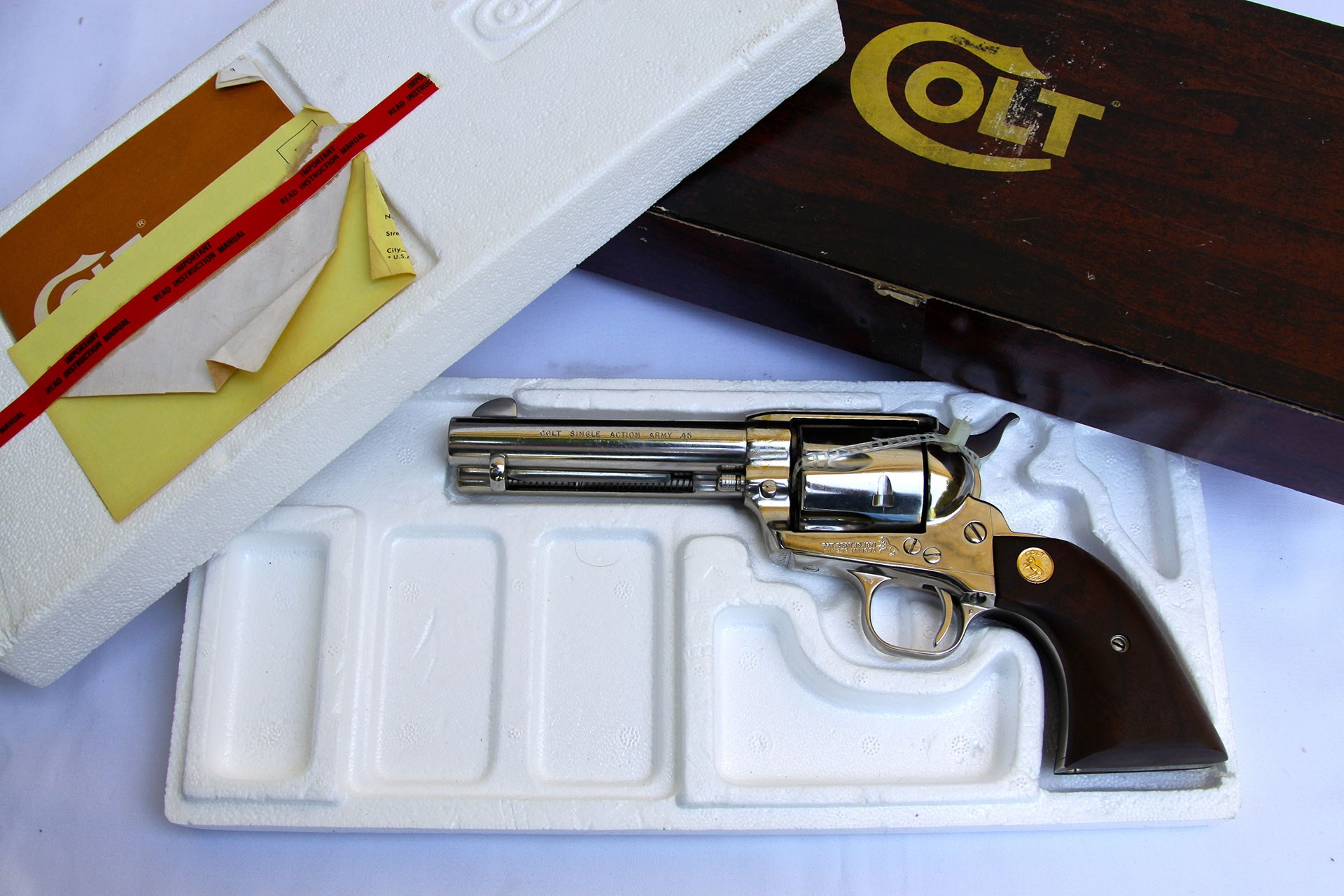 This unfired Second Generation nickel-plated SAA in .45-caliber is shown with its original wood grained cardboard box, which was introduced in 1973.
This unfired Second Generation nickel-plated SAA in .45-caliber is shown with its original wood grained cardboard box, which was introduced in 1973.
In addition, original 12" barreled Buntline Specials are among the rarest catalogued versions. Only 4,060 were made (65 of which were nickeled) but during the 1990s, when Second Generation Buntlines weren’t in great demand, many individuals re-outfitted them with 4¾" barrels. And commemoratives aside, there were fewer than 400 factory-engraved Second Generation Peacemakers made, in addition to a small number of Second Generation guns (many assembled from leftover parts) discovered in the Colt Custom Shop around 1994, and which were subsequently engraved.
Regardless of rarity, to command top dollar, a Second Generation SAA must be new and unfired, with no drag line around the cylinder, and ideally in its original box with all the factory papers. Naturally, the first thing any proud new Peacemaker owner did “back in the day” was to take the gun out of its box, cock it numerous times, then throw the box away and take the gun to the range. That’s certainly what I did with my Second Generation Colt, which I bought in 1960 (and which I still shoot regularly).
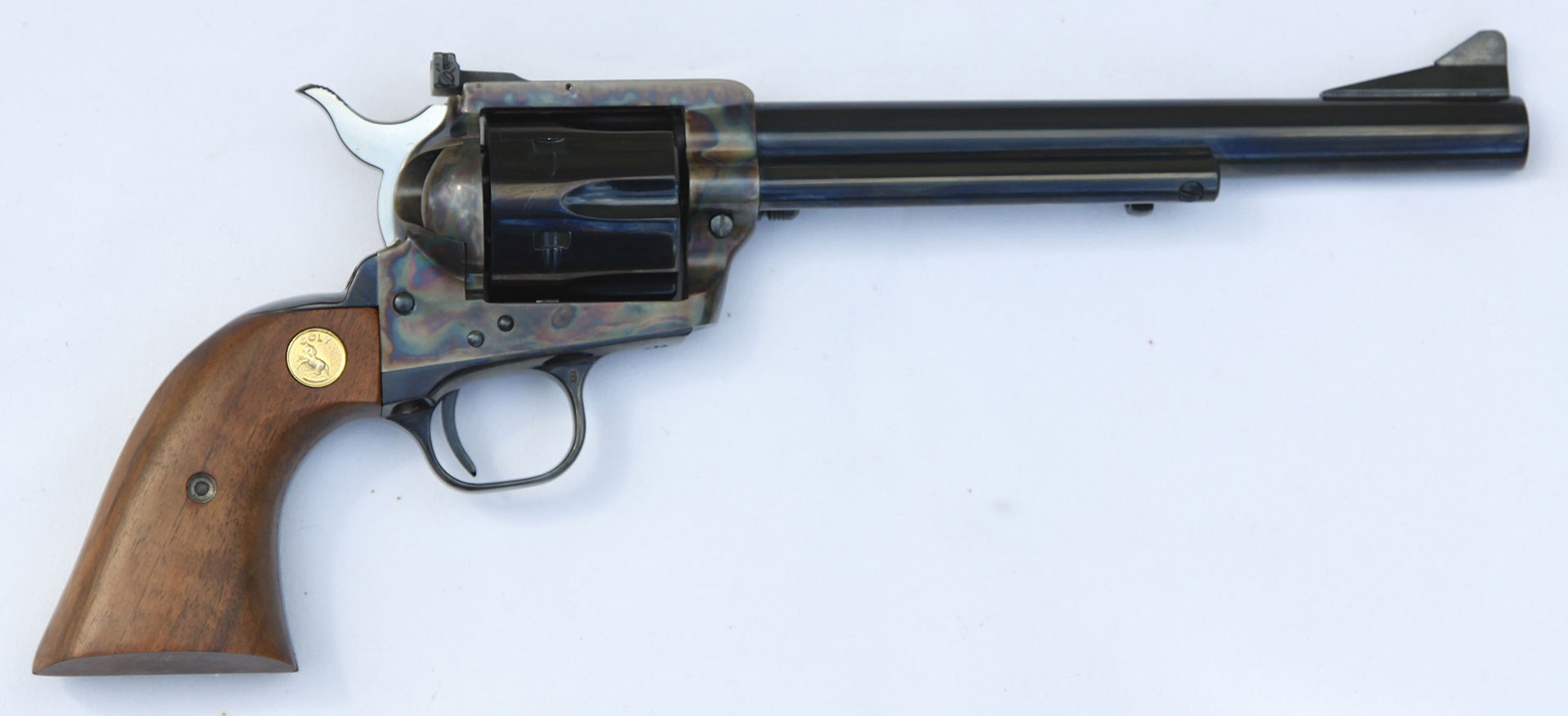 The New Frontier, an updated version of the pre-war Flat Top Target single action, was introduced in 1961 and was an adjustable-sighted version of the SAA.
The New Frontier, an updated version of the pre-war Flat Top Target single action, was introduced in 1961 and was an adjustable-sighted version of the SAA.
Today those original boxes bring $200 to $350 (beware: reproductions exist), but the right box must be with the right gun. From 1955 until 1964, Single Action Armys came in a black box, similar to First Generation boxes, with gold “Colt” lettering on the lid. Then, from 1965 until 1973, Colt used a red and white Stagecoach box. After that, Colt began using printed wood-grained boxes with two-piece styrofoam inserts. This box carried over into Third Generation guns until replaced by the current blue plastic case.
There are enough Second Generation Peacemaker variations, including hammer contours, factory stocks and special barrel lengths and serial numbers to make collecting them both fascinating and challenging. But when contemplating the purchase of any atypical Second Generation gun, I recommend spending $100 for a factory letter beforehand from Colt historian Beverly Haynes at coltarchives.com to confirm its authenticity.
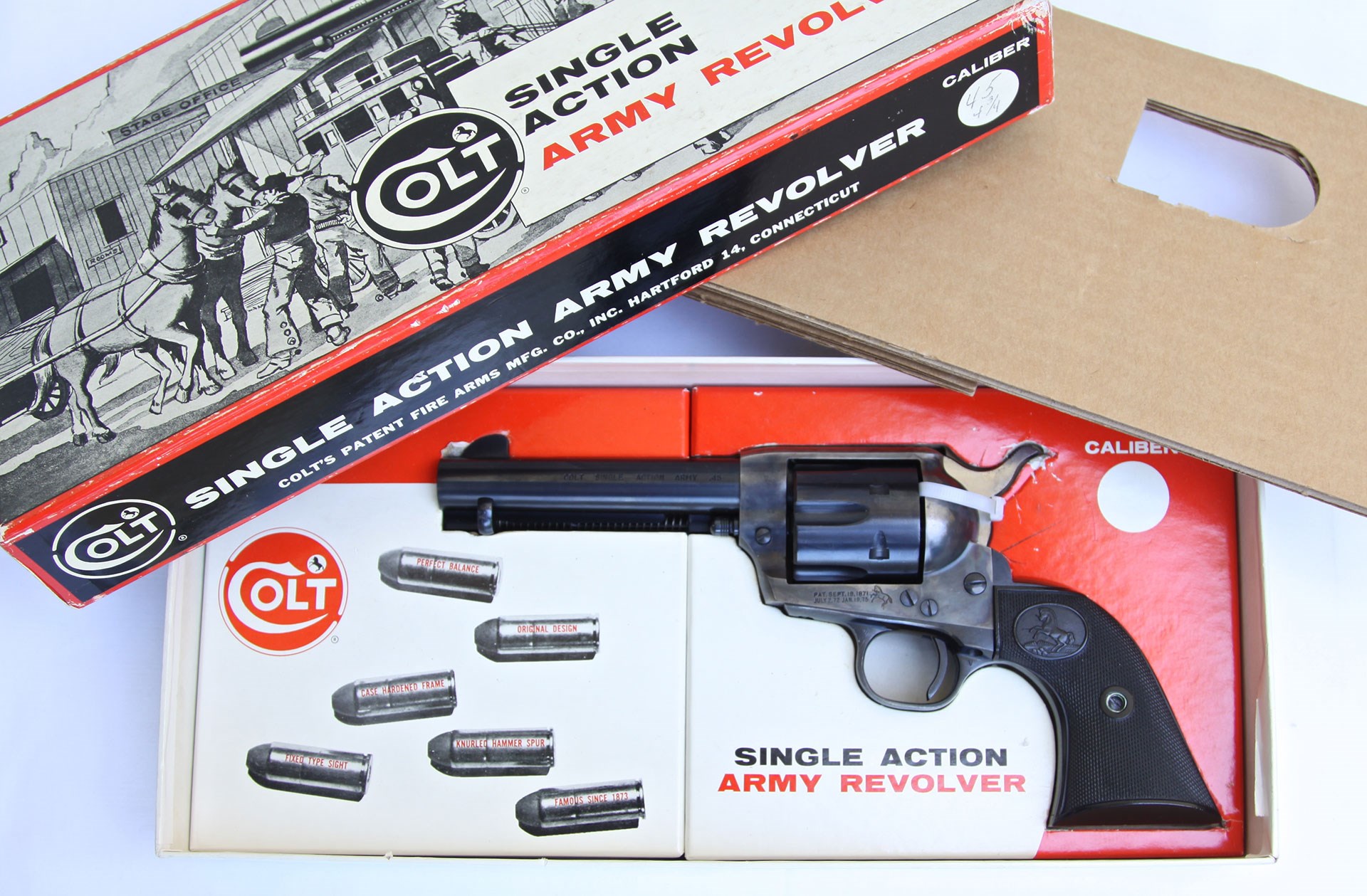 The handsome stagecoach box, shown here with an unfired .45-cal. Second Generation SAA, was used from 1965 until 1973.
The handsome stagecoach box, shown here with an unfired .45-cal. Second Generation SAA, was used from 1965 until 1973.
Interestingly, in 1880, the price for a new Colt Peacemaker was $16.50, which was about equal to a week’s pay back then—almost the same ratio as the $125 price tag was for a new Colt Peacemaker in 1956. Today, however, most Second Generation Peacemakers in NRA Good to Very Good condition are bringing prices in the low- to mid-four-figure range, well above an average weekly wage, which is hardly surprising. Single Action Army revolvers—no matter when they were made—are one of the top gun-collecting categories. Moreover, Second Generation SAA prices are now galloping along at a pace that shows no signs of slowing down. Like First Generation guns, they aren’t making them anymore, and their numbers are limited. Indeed, even though it was the second Single Action Army out of the starting gate, this Colt has already proven itself a winner.













